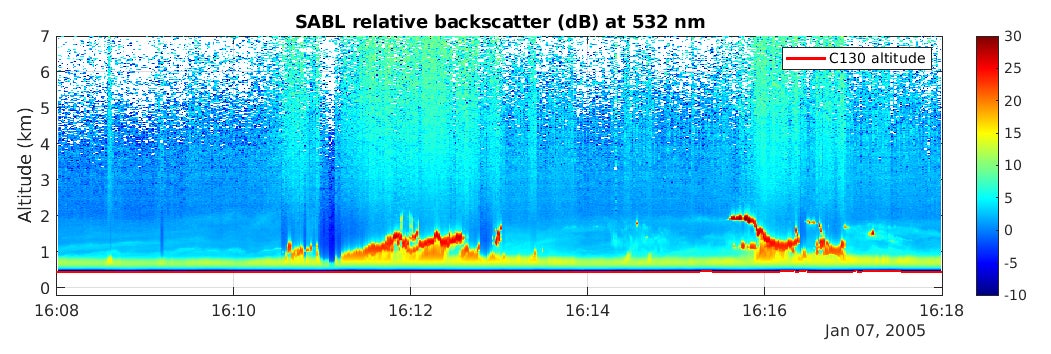Scanning Aerosol Backscatter Lidar (SABL)
SABL is no longer available for deployment.
SABL data are available in the EOL Field Data Archive.
The Scanning Aerosol Backscatter Lidar (SABL) is a compact and reliable aerosol backscatter lidar system. Some of the quantitative properties of aerosols that can be measured with SABL are extinction coefficients, scattering ratios and backscatter coefficients. SABL is mounted under the wing of the NCAR C-130 Aircraft in a fuel pod. This pod arrangement allows complete scanning of SABL through the 180 degrees off the left side of the aircraft.
The SABLE telescope is of Cassegrainian design with a 14-inch diameter and a speed of f/5. The critical components of the telescope are built of low expansion materials so that the optical performance does not change with large temperature changes. The receiver is built on an optical plate that is rigidly mounted to the base plate of the telescope to minimize the effect of vibration on system performance.
A two-channel 12-bit, 40-MHz digitizer is used in the receiver. Using these high dynamic range digitizers allows the recording of the signals from the detectors without using logarithmic amplifiers. Removing the logamps from the receiver has made the analysis for quantitative aerosol properties easier and more accurate.
To maximize the signal-to-noise ratio several things have been done in component selection. In the infrared channel the temperature of the silicon avalanche photo diode (APD) is controlled with a thermoelectric cooler. This does two things: it reduces the dark current noise of the detector and it keeps the gain of the detector stable. The temperature of the photo multiplier tube (PMT) used to detect the green signal, is also temperature controlled. The main benefit of cooling the PMT is not to reduced the dark current but to gain stability. To reduce the background noise in the system, narrow band interference filters are used.
| Parameter | Specification | |
| Wavelength/energy | 1064 nm/75 mJ 532 nm/50 mJ |
|
| Pulse length | 15 ns | |
| Pulse rate | Up to 60/s | |
| Beam divergence | 1 mrad to 4 mrad adjustable | |
| Telescope diameter/speed | 35 cm, f/5 | |
| Telescope field-of-view | 1 mrad to 5 mrad adjustable | |
| Background filter bandwidths | 0.92 nm @ 1064 nm 0.16 nm @ 532 nm |
|
| Detectors | Avalanche photo diode @ 1064 nm Photo multiplier tube @ 532 nm |
|
| Digitizer - 2 channel | 12 bits at up to 40 MHz | |
| Number of range gates per channel | Up to 2000 | |
NCAR/EOL Remote Sensing Facility. (2014). Scanning Aerosol Backscatter Lidar (SABL). UCAR/NCAR - Earth Observing Laboratory.
